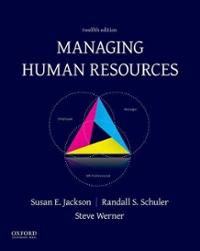Question
Type of Organisational Culture at SEMCO Antonio Curt Semler graduated from Vienna s Polytechnic University as an Australian engineer. Upon graduation, his goal was
Type of Organisational Culture at SEMCO
Antonio Curt Semler graduated from Viennas Polytechnic University as an Australian engineer. Upon graduation, his goal was to find a challenging business venture abroad. In Antonio Semler accepted a job offer in Argentina. There, he managed a plant for DuPont until In Antonio Semler traveled to Brazil and realized he was keen on staying in So Paulo as he believed it to be a prime location for an entrepreneur like himself. It was in So Paulo Brazil that Semler founded Semler & Company in At this time Semco was a simple backyard machine shop. The Brazilian market offered many opportunities and Semler & Company soon became a market leader by purchasing contracts that provided marine pumps to the military. By the s Semler & Company was a wellestablished manufacturer that employed around employees and generated around $ million in revenues a year. Semler & Company started as a paternalistic, pyramidal structured company structured with rules and autocratic leadership. This kind of organizational design was commonly found in LatinAmerican companies during this time making Semler & Company a traditional company in every respect. Antonio Curt Semler followed a completely different organizational philosophy compared to his sons future management style. When Ricardo Semler graduated from Harvard at the age of he began working in his fathers company. In addition to Ricardo Semlers ideal of a strict separation of work and personal life, the father and son faced a large amount of conflict. Things changed in when Ricardo Semler took over his fathers company. Ricardo Semler was convinced that the future success of Semler & Company lied in the diversification of products but nobody and especially not his father listened. Frustrated by this and the organizational philosophy of his father, Ricardo Semler threatened to leave the company in his third year. At that moment Antonio Curt Semler retired, as CEO of Semler & Company and became a turning point for the company and its employees. Ricardo Semler immediately put some drastic changes in order. He renamed the company Semco, modernized the management practices and expanded the companys range with a product diversification strategy.
When Ricardo Semler took over his fathers company in he was only years old. He was young and ambitious, and he had the aspiration to make Semco a model of efficiency. Therefore, he hired top qualified managers, adopted new and complex technology and worked long days. It was not until he suddenly fainted and was diagnosed with a severe case of stress that he realized he needed to change his way of living and that of his employees as well. That is when he came up with the idea of a democracy in the workplace which is based on three interdependent core values, employee participation, profit sharing and freeflow of information.
Between and Semco's productivity increased nearly sevenfold, and profits rose fivefold. Semco was also one of the most soughtafter Brazilian companies as far as employment was concerned. Turnover among its employees was about during the period to Repeat customers accounted for around of Semco's annual revenues. The culture at Semco was unique in the sense that there were no powerpacked job titles; employees including top managers themselves did the photocopying, sent faxes, typed letters, and made and received phone calls. There were no executive dining rooms, and parking was strictly firstcome, firstserved. Organizational profits were shared with the employees and the salaries were set by the employees themselves.
Semco has evolved into a very successful, innovative organisation with various linked and unrelated business interests, governed mostly by Semco employees rather than top leadership. Whilst the organisation loses very few people due to attrition, it receives hundreds of applications from prospective employees enthusiastic about working in a reputable and respectful organisation. In general, the removal of bureaucracy has enabled this organisation to become exceptionally agile and flexible in a constantly changing business environment. Behind this "maverick" organization was Ricardo Semler Semler the CEO of the company who referred to himself as the Chief Enzyme Officer.
Adapted from Thunderbird, The American Graduate School of International Management
Differentiate Semcos organisational culture before and after the changes made by Ricardo Semler?
Marks
Analyse the similarities and differences of Semco organisation culture from the point of view of Adhocracy culture?
Marks
Step by Step Solution
There are 3 Steps involved in it
Step: 1
1 Differentiation of Semcos Organizational Culture Before and After the Changes Made by Ricardo Semler Before the Changes Semler Company later Semco was founded by Antonio Curt Semler and had a tradit...
Get Instant Access to Expert-Tailored Solutions
See step-by-step solutions with expert insights and AI powered tools for academic success
Step: 2

Step: 3

Ace Your Homework with AI
Get the answers you need in no time with our AI-driven, step-by-step assistance
Get Started


